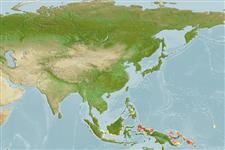Classification / Names
Nombres comunes | Sinónimos | Catalog of Fishes(Género, Especie) | ITIS | CoL | WoRMS | Cloffa
>
Siluriformes (Catfishes) >
Ariidae (Sea catfishes) > Ariinae
Etymology: hardenbergi: Named for J.D.F. Hardenberg who recognized this species as new, as well as for his insightful contributions to the Indo-Australian ichthyology in the mid-twentieth century (Ref. 40908).
Issue
This species is placed in the genus Hemiarius in Eschmeyer (CofF ver. Jul. 2011: Ref. 87661) following Marceniuk & Menezes (2007: Ref. 58022). It is treated here under the genus Aspistor following Ferraris (2007: Ref. 58032). Please send references, or more studies are needed.
Environment: milieu / climate zone / depth range / distribution range
Ecología
marino; salobre demersal. Tropical
Western Central Pacific: southern New Guinea, from the Vogelkop Peninsula to the Fly River mouth.
Tamaño / Peso / Age
Maturity: Lm ? range ? - ? cm
Max length : 25.4 cm SL macho / no sexado; (Ref. 40908)
Short description
Morfología | Morfometría
Espinas dorsales (total): 1; Radios blandos dorsales (total): 7; Espinas anales 0; Radios blandos anales: 16 - 18; Vértebra: 50 - 52. Four patches of conical teeth across front of palate; rounded vomerine patches well-separated; outer patches oval or crescentic, 2-3 times larger than inner patches. Snout fleshy, overhanging mouth. Low papillae on palate and posterior face of gill arches; rakers rarely on posterior face of first two gill arches. Barbels thick proximally, thin distally. Head shield very granular, extensive posteriorly; triangular supraoccipital process short, broad. Eye small, dorsolateral. 8-12% HL. Adipose fin large, base longer than anal fin base. Dark grey in color; inner, dorsal aspect of paired fins charcoal blue (Ref. 40908).
Inhabits muddy, shallow coastal waters and tidal rivers (Ref. 40908).
Life cycle and mating behavior
Madurez | Reproducción | Puesta | Huevos | Fecundidad | Larva
Ferraris, C.J. Jr., 2007. Checklist of catfishes, recent and fossil (Osteichthyes: Siluriformes), and catalogue of siluriform primary types. Zootaxa 1418:1-628. (Ref. 58032)
IUCN Red List Status (Ref. 130435)
Threat to humans
Traumatogenic (Ref. 58010)
Human uses
Más información
Nombres comunesSinónimosMetabolismoDespredadoresEcotoxicologíaReproducciónMadurezPuestaAgregación para la puestaFecundidadHuevosEgg development
Age/SizeCrecimientoLength-weightLength-lengthLength-frequenciesMorfometríaMorfologíaLarvaDinámica larvariaReclutamientoAbundanciaBRUVS
ReferenciasAcuiculturaPerfil de acuiculturaRazasGenéticaElectrophoresesheritabilidadEnfermedadesProcesamientoNutrientsMass conversion
ColaboradoresImágenesStamps, Coins Misc.SonidosCiguateraVelocidadTipo de nataciónSuperficie branquialOtolitosCerebrosVisión
Herramientas
Special reports
Download XML
Fuentes de Internet
Estimates based on models
Preferred temperature (Ref.
123201): 28 - 29.2, mean 28.8 °C (based on 303 cells).
Phylogenetic diversity index (Ref.
82804): PD
50 = 0.6250 [Uniqueness, from 0.5 = low to 2.0 = high].
Bayesian length-weight: a=0.01000 (0.00244 - 0.04107), b=3.04 (2.81 - 3.27), in cm total length, based on all LWR estimates for this body shape (Ref.
93245).
Nivel trófico (Ref.
69278): 3.5 ±0.5 se; based on size and trophs of closest relatives
Resiliencia (Ref.
120179): Medio, población duplicada en un tiempo mínimo de 1.4-4.4 años (Preliminary K or Fecundity.).
Fishing Vulnerability (Ref.
59153): Low vulnerability (21 of 100).
